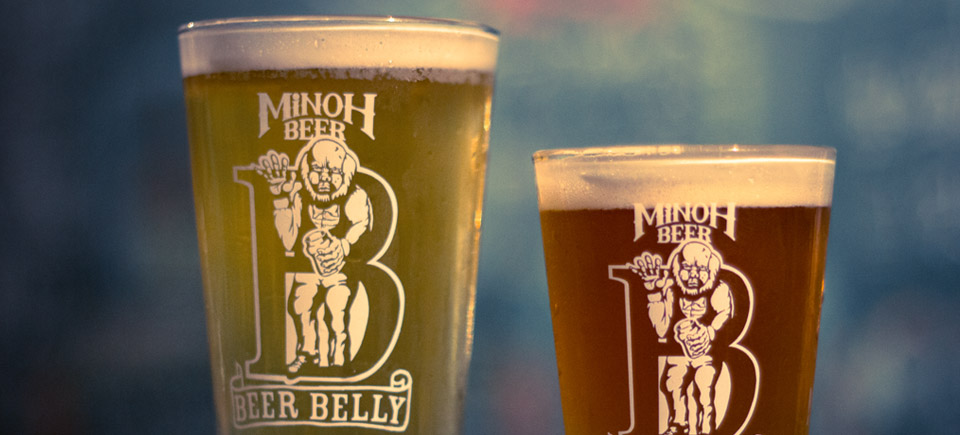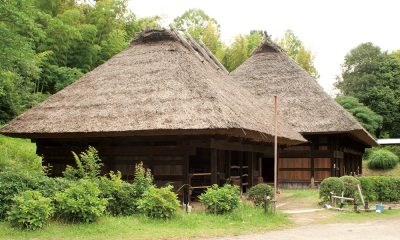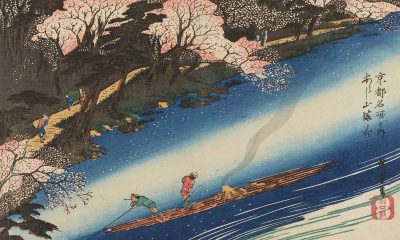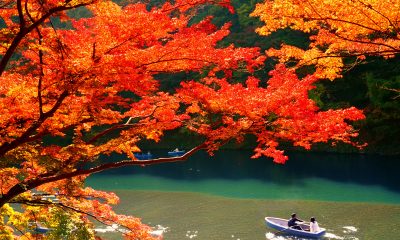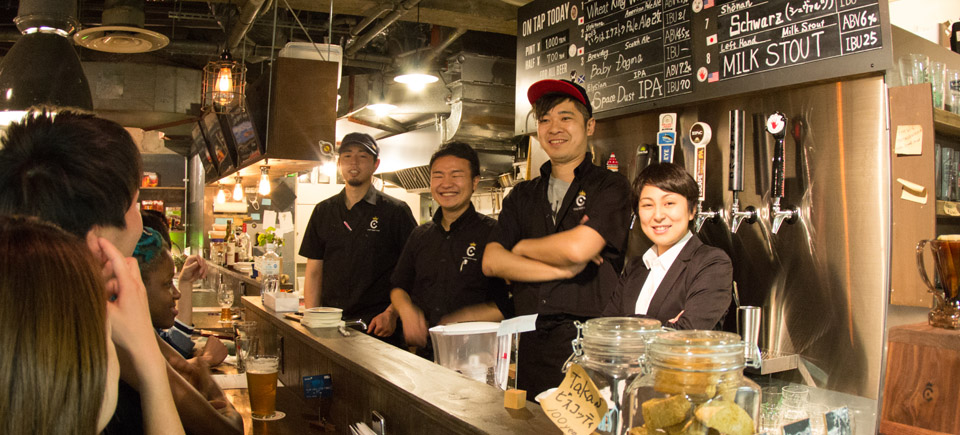Feature
The Craft Beer Splash
The craft has been honed, and ji-biru is booming. If you haven’t already, it’s time to sit up and take notice of “the beer of the land.”
“The Dutch make sake from grapes, and they also make sake from barley. I had a chance to drink this latter, and it was absolutely horrible. It had no flavor at all, and they call it bier…”
Sacrilege as it may seem, this was apparently the first impression of the Tokugawa Shogunate after tasting beer for the first time when the Dutch brought it to Edo as part of a tribute in 1727. The statement was published at the time in the Dutch record, Oranda Mondo (Discussions with the Hollanders).
No one could have predicted the meteoric rise of beer in Japan and that indeed, its main players would all be Japanese brands. A scene that even today it is still on the up and up with the new breed of craft beer – ji-biru – that has been gaining momentum in leaps and bounds.
The Birth of Ji-biru
Ji-biru, which literally translates to “beer of the land” is what we would associate with “craft beer” or “micro beer” in the West. These days, the term kurafuto biru is also used to distinguish between the high-quality beers produced after the birth of craft beer in Japan from the not-so-highquality stuff.
Japanese craft beer proliferated after a strict minimum-brewing law in place from 1908 was relaxed. The law stipulated that in order to have a brewing license, a brewer had to produce 180,000 liters a year. This was lifted in 1940 to 1.8 million liters, and raised again to two million in 1959, making it impossible for anyone to get into the brewing game that wasn’t already established.
All this finally changed in 1994 when a new law lowered the minimum brewing capacity to 60,000 liters a year. This catalyzed the craft beer movement in Japan, but it was a case of first comes quantity, and much later comes quality.
“The overwhelming positive was that you had craft beer, but this explosion of microbrewing led to more than 400 microbreweries popping up all over Japan – most in the simple hope of making a big profit rather than any real desire to make well-crafted beer,” explained Mark Meli, a regular contributor to Japan Beer Times magazine and the author of Craft Beer in Japan – the definitive English guide to all things Japanese craft beer.
Everyone and their obachan was getting into the ji-biru business; restaurants, hotels, museums, you name it. “Today we have about 240 craft beer breweries in Japan, a lot of the others closed because the beer was terrible,” Meli said.
The Scene in Kansai
Since about 2012, craft beer bars have been mushrooming throughout Kansai with new places continuously popping up. The craft haunts with a bit of a longer history, like Qbrick, which just celebrated its 10-year anniversary, and Beer Belly, opened after the Minoh beer brand was launched in 1996, have blazed the trail, helping to pave the ji-biru landscape and build the now fast-growing scene.
“Kansai has a really strong community for craft beer … part of that is having so many (craft beer bars) in the same area,” says Mike Post, also known as Mr. Beer Zen, the founder of the quarterly Beer Zen magazine. Having just celebrated its two-year anniversary, the magazine has also been instrumental in driving the scene with its simple goal: “to connect people to people, and of course people to great beer!”
“The scene has steadily grown with a big boom in 2012 with Yellow Ape, Molto, Craft Beer Base, and Kamikaze opening and another big boom this past March with a lot of owners opening their second shops,” Post explained.
As far as what is driving the scene, the craft beer culture is more in line with a “foodie” culture, which is reflected in the chic atmosphere and mouthwatering food served at these places. This might also explain why the patrons differ from what one usually expects, particularly in a Western country, when ‘heading out to the pub for a pint.’
“Women drive the scene to a certain degree. They know what’s cool, what’s going on. There is a misconception that beer is a man’s drink in the West, but everyone likes beer!” explained Post.
It’s not limited to women just knowing what’s happening in the scene either – they are also brewing the beer. “More than half the brewers in Kansai are women,” said Mark Meli. They are drinking it, making it and running the bars that sell it.
Probably the most renowned in Kansai craft beer, Minoh brewery was founded in 1996 when a successful liquor store owner named Masaji Ohshita established the brewery and charged his three daughters with running the place. Ever since, the Ohshita sisters have been concocting some very tasty brews that have won them many Japanese and International awards.
Another influential woman on the scene, as the owner and operator of two very successful craft beer bars and one craft beer bottle shop, Ai Tani is determined to bring the exploding Japanese craft beer scene to the world. Her flagship shop for her brand Craft Beer Base just celebrated its third anniversary this year, with Craft Beer Base Seed (her bottle shop) opening in 2013, and Craft Beer Base Bud (a bar) budding to life just this year.
Having traveled around Europe to learn from the best, Ai also acts as a judge in Japan and abroad for international beer competitions. Developing a refined palate to match her keen business mind, she is a growing force on the ji-biru movement locally and abroad.
The Future of the Scene
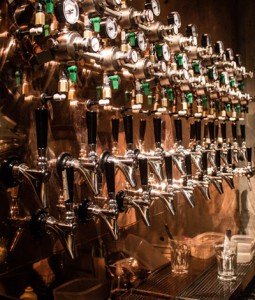 While future of the general scene looks bright, it still has a long way to go. “Right now, it’s not a destination for breweries, but if you like craft beer and you visit you will be pleasantly surprised with what’s on offer,” said Mike Post.
While future of the general scene looks bright, it still has a long way to go. “Right now, it’s not a destination for breweries, but if you like craft beer and you visit you will be pleasantly surprised with what’s on offer,” said Mike Post.
There used to be more of a focus on German-style beers in Japan’s craft beer scene, but the trend has now shifted towards American styles. Mark Meli explained that “a tidal wave of American craft beer has come in and the companies with the most success, with some exceptions, are doing American styles.” The popularity of American craft beer in Japan has inspired many breweries to be bolder with their use of hops, and IPAs are becoming a more fashionable style; a stark contrast to the lagers turned out by the big four.
As for the obstacles holding back craft beer locally, one is price – at ¥1,000 a pint, due in part to heavy taxes and the need to import hops, double the standard draft beer price tag is enough to chase people away.
Another factor is the availability of craft beer to regular local watering holes. Izakaya are usually under contract with one of the big four brewers, and as result, only carry their beer, but Meli thinks it will change. “I’d like to see it in izakayas and I think it will happen. Ten years ago in the States you had to look for it, now you can find it in gas stations.”
In Japan there is such a close tie between beer and food that Maek Post believes a key way forward is understanding pairings between the two. “As Japanese people learn an IPA goes well with this and a Stout goes well with that, craft beer will become more popular … that’s part of the marketing,” he said.
While the shop boom in Kansai has been spreading craft beer culture and sales, it is a niche market, making up about one percent of the total market in Japan. However, that hasn’t stopped the major Japanese brands from seeing the potential money in it. They too have thrown their hats in the ring, hoping to cash in on the budding popularity with all four major breweries rolling out craft beer lines.
The craft beer scene in Kansai has dramatically changed from just a few pubs 10 years ago to more than 50 craft beer spots currently, the majority being in Osaka. With Minoh beer still going strong, and promising up-and-coming players such as the Kyoto Brewing Company turning heads at craft beer festivals around the region, there’s no better time than now to get out there and see what all the hype is about.
クラフトビールの魅力
見事な醸造技術で、地ビールのイメージを大きく向上させたクラフトビー ル。かつてないブームを迎えている今、地元産の美味しいビールに出会うチャンスだ。
「オランダ人はブドウから酒を造り、麦からも酒を造るそうだ。麦酒を飲んでみたが思いのほか不味く、あじわいも何もあったものではない。名前はビールというらしい」
1727年頃に記されたオランダ商館長と幕府役人の問答集『和蘭問答』からの一節 である。献上品として江戸城内に持ち込まれたビールを、当時の八代将軍徳川吉宗も味見したのだろうか。
やがて日本ではピルスナータイプのラガービール醸造が隆盛し、ビッグ4と呼ばれる 国産メーカーが登場する。レストラン、居酒 屋、スーパー、コンビニなどでビールが売られ、日本全国で地ビールが生産されることになろうとは、当時の将軍も知る由はない。
地ビールの誕生
日本の「地ビール」は、西洋のクラフトビールやマイクロビールに相当する概念だ。最近すっかり定着した「クラフトビール」という呼称には、玉石混交の地ビールより高品質であるという差別化の意味合いも含まれている。
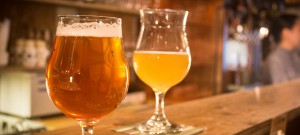 日本のクラフトビールは、1908年施行の酒税法で規定された「最低製造数量基準」が緩和されることで誕生した。もともと酒類製造免許の取得には最低でも年間18万リットルの製造が義務づけられていたが、この最低製造量が1940年には180万リットル、1959年には200万リットルと引き上げられ、既存の業者以外は参入不可能になっていた。これが1994年の酒税法改正で一気に年間6万リッターまで引き下げられ、地ビールブームを引き起こしたのである。だが当初のブームは質より量を重視する生産者が目立ち、品質が追い付いてくるまでに長い時間がかかった。
日本のクラフトビールは、1908年施行の酒税法で規定された「最低製造数量基準」が緩和されることで誕生した。もともと酒類製造免許の取得には最低でも年間18万リットルの製造が義務づけられていたが、この最低製造量が1940年には180万リットル、1959年には200万リットルと引き上げられ、既存の業者以外は参入不可能になっていた。これが1994年の酒税法改正で一気に年間6万リッターまで引き下げられ、地ビールブームを引き起こしたのである。だが当初のブームは質より量を重視する生産者が目立ち、品質が追い付いてくるまでに長い時間がかかった。
「地ビールの誕生は大きな前進でした。 ビール醸造がブームになり、日本全国で 400以上もの小規模ビール醸造所ができました。でも多くはひと儲けを狙っただけの参入者で、本当に高品質なクラフトビールを生産しようという志の人が少なかったのも事実です」
そんな当時の状況を教えてくれるのは、 日本初のクラフトビール専門誌「ジャパン・ビア・タイムズ」のレギュラー執筆者を務めるマーク・メリさん。英語で書かれたビール ガイドの決定版『クラフト・ビア・イン・ジャパ ン』の著者でもある。
「やがてレストラン、ホテル、美術館などで、さまざまな人が地ビールのビジネスに関わるようになりました。今日では日本に約240のクラフトビール醸造所があります。ビールの出来が悪かった醸造所の多くは閉鎖されました」
関西のクラフトビールシーン
関西でクラフトビールの店が次々にオー プンしたのは2012年頃のことだが、その背景には先駆者たちが築いてきた歴史もある。10周年を祝ったばかりの「Qbrick」や、1996年に設立された箕面ビール直営店 「BEER BELLY」などが、急成長を続ける 地ビールシーンの土台を作った。
「関西にはクラフトビールの根強いコミ ュニティがありますが、同じ地域にたくさんのクラフトビールバーが密集しているのも その一因です」
そう説明するのは、季刊誌「ビア・ゼン」 を主宰するミスター・ビア・ゼンことマイク・ポストさん。発行2周年を迎えた同誌は「人と人をつなぎ、人と美味しいビールをつなぐ」をモットーに日本のクラフトビールを応援してきた。
「YELLOW APE、MOLTO、CRAFT BEER BASE、KAMIKAZEなどの店が次 々に開店した2012年の大ブーム以来、クラフトビールシーンは着実に成長してきました。これらの店の多くが今年3月に相次いで2号店を出し、現在は第2のブームが起きています」
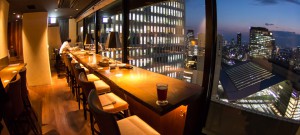 クラフトビールの店は、どこもシックな雰囲気で美味しい料理を提供している。クラフトビールと食文化は切り離せない。「パブに1杯飲りにいく」という西洋文化とは一線を画している点に、各店オーナーたちのこだわりがあるとポストさんは指摘する。
クラフトビールの店は、どこもシックな雰囲気で美味しい料理を提供している。クラフトビールと食文化は切り離せない。「パブに1杯飲りにいく」という西洋文化とは一線を画している点に、各店オーナーたちのこだわりがあるとポストさんは指摘する。
「ブームの一翼を担っているのは女性客です。女性はセンスが良いものを好み、流行にとても敏感。西洋ではビールが男性の飲み物だという誤解がありますが、やっぱりビールはみんな大好きですからね」
クラフトビールのファンだけでなく、ビール造りに関わっている人にも女性が多い。メリさんによると、関西のビール醸造家の半数以上は女性。飲むのも、造るのも、店を経営するのも、今や女性が主役なのだという。
おそらく関西のクラフトビールでもっとも有名な「箕面ビール」も、女性がリーダーを務めている。酒屋の経営で成功した大下正司さんが1996年に設立し、大下香緒里さ んら3人の実娘に経営が引き継がれた。近 年も素晴らしい味のビールで国内外の賞に輝いている。
クラフトビールシーンを牽引する女性と いえば、谷和さんも忘れてはならない。経営 する「CRAFT BEER BASE」(バー)は今 年で開店3周年を祝ったばかりで、2013 年開店の「CRAFT BEER SEED」(ボト ルショップ)、今年オープンした「CRAFT BEER BASE BUD」(バー)も好評。3つの 店舗を拠点に、日本のクラフトビール文化を 世界に発信している。ヨーロッパ中を旅行し てさまざまな有名ビール醸造所を訪ねた谷 さんは、国内外のビールコンペティションで審査員の経験も豊富。意欲的なビジネスマインドと繊細な味覚で、地ビールムーブメントを推進中だ。
ブームの未来
クラフトビールの未来は明るそうだが、まだ 道のりは長いとポストさんは語る。
「クラフトビールが目当てで関西にやってくる人はまだまだ少数。それでも、関西に来たクラフトビールファンを驚かせるレベルには達しています」
日本のクラフトビールといえば、これまではドイツ流のビール醸造が主流だった。しかし今ではアメリカ流のスタイルにトレンドが移行している。メリさんがこの状況を説明する。
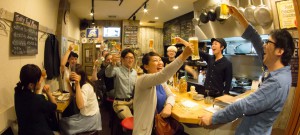 「いくつか例外があるものの、現在成功 を収めている会社の多くはアメリカンスタ イルを採用しています。アメリカ産クラフト ビールの人気は、大胆なホップの使い方な どで日本のビール醸造家たちを開眼させま した。インディアペールエール(IPA)にもお 洒落なイメージが定着して、4大メーカーが 生産するラガービールとは対照的な立ち位 置を獲得しています」
「いくつか例外があるものの、現在成功 を収めている会社の多くはアメリカンスタ イルを採用しています。アメリカ産クラフト ビールの人気は、大胆なホップの使い方な どで日本のビール醸造家たちを開眼させま した。インディアペールエール(IPA)にもお 洒落なイメージが定着して、4大メーカーが 生産するラガービールとは対照的な立ち位 置を獲得しています」
クラフトビールの人気は、まだ地元だけに留まっている。その原因のひとつが、1パイント約1,000円という価格だ。高い酒税とホップの輸入コストのせいで、通常の生ビー ルと比べて倍近い値段になってしまう。
もうひとつの障壁は、一般的な酒場で入手しにくいこと。居酒屋はたいてい4大メーカーのどこかと契約を交わしており、結果として1社独占のような店も多い。だがこの状況もいずれは変わっていくだろうとメリさんは見ている。
「居酒屋でクラフトビールが扱われるのを見たいし、いつか実現できると思う。10年前は探さなければ入手不可能だったクラフトビールも、アメリカではガソリンスタンドで売られていますから」
日本ではビールと料理に深いつながりがある。だからその相性について理解を深めることが、ブーム拡大の鍵をにぎるとポストは主張する。
「IPAにはこの料理が合う、スタウトにはこのスナックがいいなどと、日本のファンが独自に味覚を開拓していけばさらに人気が高まるでしょう。これはマーケティングの問題でもありますね」
関西では店舗単位のブームがクラフトビール文化の普及に貢献してきた。クラフトビールの売り上げは伸びているが、ニッチな市場なので日本全体のビール市場の1%に過ぎない。しかしこの現象に大手も反応した。商機があると見るや、4大メーカー全社 がクラフトビールの生産ラインを動かし始めている。
わずか数店舗で始まった10年前の状況から、関西のクラフトビールシーンは激的に 変化した。現在は大阪を中心に50以上のクラフトビールスポットがある。箕面ビールには以前として大きな存在感があり、京都醸造株式会社などの有望な生産者が地域のクラフトビールフェスティバルなどで頭角を現している。
こんな今こそ、ブームの現場でクラフトビールの魅力をとことん体験してみてはいかがだろうか。


